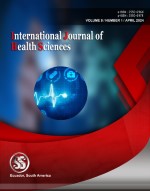Radiological evaluation of pulmonary embolism: Advances in diagnostic accuracy and imaging techniques
Keywords:
Pulmonary embolism, CT pulmonary angiography, MRI, catheter pulmonary angiography, diagnostic imagingAbstract
Background: Acute pulmonary embolism (PE) is a frequent, life-threatening condition predominantly caused by venous thromboembolism. Accurate and timely diagnosis is crucial for effective treatment, and imaging plays a central role in detecting PE. Recent advancements in imaging techniques have significantly improved diagnostic accuracy. Aim: This article reviews various radiological modalities for evaluating acute PE and their advances in diagnostic capabilities. Methods: The study examines the use of CT pulmonary angiography (CTPA), MRI, catheter pulmonary angiography, and other imaging techniques, such as echocardiography and nuclear medicine, highlighting their clinical applications and diagnostic precision. Results: CTPA is identified as the gold standard for diagnosing PE due to its high accuracy and speed, while MRI serves as a suitable alternative in patients with contraindications to iodinated contrast agents. Catheter angiography, though mostly replaced by CTPA, remains valuable for interventional treatments. Emerging techniques like dual-energy CT and non-contrast MRI show promise in enhancing diagnostic outcomes. Conclusion: Advances in imaging, including dual-energy CT and MRI, have improved diagnostic accuracy for PE, with each technique offering unique advantages. These innovations contribute to earlier detection, improved treatment planning, and better patient outcomes in acute PE management.
Downloads
References
Han D, Lee KS, Franquet T. et al. Thrombotic and nonthrombotic pulmonary arterial embolism: spectrum of imaging findings. Radiographics 2003; 23: 1521-1539 DOI: https://doi.org/10.1148/rg.1103035043
Raja AS, Greenberg JO, Qaseem A. et al. Evaluation of Patients With Suspected Acute Pulmonary Embolism: Best Practice Advice From the Clinical Guidelines Committee of the American College of Physicians. Ann Intern Med 2015; 163: 701-711 DOI: https://doi.org/10.7326/M14-1772
Laack TA, Goyal DG. Pulmonary embolism: an unsuspected killer. Emerg Med Clin North Am 2004; 22: 961-983 DOI: https://doi.org/10.1016/j.emc.2004.05.011
Konstantinides SV, Torbicki A, Agnelli G. et al. 2014 ESC guidelines on the diagnosis and management of acute pulmonary embolism. Eur Heart J 2014; 35: 3033-3069, 3069a-3069k
Cohen AT, Agnelli G, Anderson FA. et al. Venous thromboembolism (VTE) in Europe. The number of VTE events and associated morbidity and mortality. Thromb Haemost 2007; 98: 756-764 DOI: https://doi.org/10.1160/TH07-03-0212
Raczeck P, Minko P, Graeber S. et al. Influence of Respiratory Position on Contrast Attenuation in Pulmonary CT Angiography: A Prospective Randomized Clinical Trial. Am J Roentgenol 2016; 206: 481-486 DOI: https://doi.org/10.2214/AJR.15.15176
Wittram C. How I do it: CT pulmonary angiography. Am J Roentgenol 2007; 188: 1255-1261 DOI: https://doi.org/10.2214/AJR.06.1104
Loud PA, Katz DS, Bruce DA. et al. Deep venous thrombosis with suspected pulmonary embolism: detection with combined CT venography and pulmonary angiography. Radiology 2001; 219: 498-502 DOI: https://doi.org/10.1148/radiology.219.2.r01ma26498
Goldhaber SZ, Bounameaux H. Pulmonary embolism and deep vein thrombosis. Lancet 2012; 379: 1835-1846 DOI: https://doi.org/10.1016/S0140-6736(11)61904-1
Lu GM, Luo S, Meinel FG. et al. High-pitch computed tomography pulmonary angiography with iterative reconstruction at 80 kVp and 20 mL contrast agent volume. Eur Radiol 2014; 24: 3260-3268 DOI: https://doi.org/10.1007/s00330-014-3365-9
Albrecht MH, Bickford MW, Nance JW. et al. State-of-the-Art Pulmonary CT Angiography for Acute Pulmonary Embolism. Am J Roentgenol 2017; 208: 495-504 DOI: https://doi.org/10.2214/AJR.16.17202
Kalisz K, Halliburton S, Abbara S. et al. Update on Cardiovascular Applications of Multienergy CT. Radiographics 2017; 37: 1955-1974 DOI: https://doi.org/10.1148/rg.2017170100
Ghandour A, Sher A, Rassouli N. et al. Evaluation of Virtual Monoenergetic Images on Pulmonary Vasculature Using the Dual-Layer Detector-Based Spectral Computed Tomography. J Comput Assist Tomogr 2018; 42: 858-865 DOI: https://doi.org/10.1097/RCT.0000000000000748
Benson DG, Schiebler ML, Nagle SK. et al. Magnetic Resonance Imaging for the Evaluation of Pulmonary Embolism. Top Magn Reson Imaging 2017; 26: 145-151 DOI: https://doi.org/10.1097/RMR.0000000000000133
Ingrisch M, Maxien D, Meinel FG. et al. Detection of pulmonary embolism with free-breathing dynamic contrast-enhanced MRI. J Magn Reson Imaging 2016; 43: 887-893 DOI: https://doi.org/10.1002/jmri.25050
Stein PD, Chenevert TL, Fowler SE. et al. Gadolinium-enhanced magnetic resonance angiography for pulmonary embolism: a multicenter prospective study (PIOPED III). Ann Intern Med 2010; 152: 434-443, W142-W143 DOI: https://doi.org/10.7326/0003-4819-152-7-201004060-00008
Kalb B, Sharma P, Tigges S. et al. MR imaging of pulmonary embolism: diagnostic accuracy of contrast-enhanced 3D MR pulmonary angiography, contrast-enhanced low-flip angle 3D GRE, and nonenhanced free-induction FISP sequences. Radiology 2012; 263: 271-278 DOI: https://doi.org/10.1148/radiol.12110224
Bauman G, Scholz A, Rivoire J. et al. Lung ventilation- and perfusion-weighted Fourier decomposition magnetic resonance imaging: in vivo validation with hyperpolarized 3He and dynamic contrast-enhanced MRI. Magn Reson Med 2013; 69: 229-237 DOI: https://doi.org/10.1002/mrm.24236
Bhatt A, Al-Hakim R, Benenati JF. Techniques and Devices for Catheter-Directed Therapy in Pulmonary Embolism. Tech Vasc Interv Radiol 2017; 20: 185-192 DOI: https://doi.org/10.1053/j.tvir.2017.07.008
Tanabe Y, Landeras L, Ghandour A. et al. State-of-the-art pulmonary arterial imaging – Part 1. VASA 2018; 47: 345-359 DOI: https://doi.org/10.1024/0301-1526/a000708
Kruger, P. C., Eikelboom, J. W., Douketis, J. D., & Hankey, G. J. (2019). Pulmonary embolism: update on diagnosis and management. Med J Aust, 211(2), 82-7. DOI: https://doi.org/10.5694/mja2.50233
Published
How to Cite
Issue
Section
Copyright (c) 2020 International journal of health sciences

This work is licensed under a Creative Commons Attribution-NonCommercial-NoDerivatives 4.0 International License.
Articles published in the International Journal of Health Sciences (IJHS) are available under Creative Commons Attribution Non-Commercial No Derivatives Licence (CC BY-NC-ND 4.0). Authors retain copyright in their work and grant IJHS right of first publication under CC BY-NC-ND 4.0. Users have the right to read, download, copy, distribute, print, search, or link to the full texts of articles in this journal, and to use them for any other lawful purpose.
Articles published in IJHS can be copied, communicated and shared in their published form for non-commercial purposes provided full attribution is given to the author and the journal. Authors are able to enter into separate, additional contractual arrangements for the non-exclusive distribution of the journal's published version of the work (e.g., post it to an institutional repository or publish it in a book), with an acknowledgment of its initial publication in this journal.
This copyright notice applies to articles published in IJHS volumes 4 onwards. Please read about the copyright notices for previous volumes under Journal History.
















